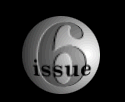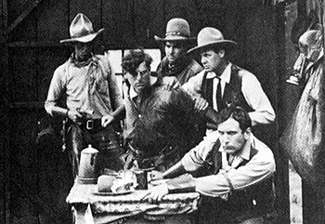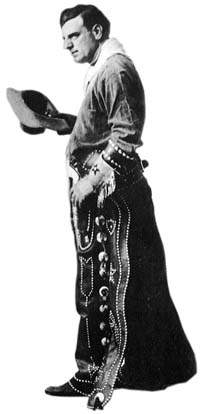


| ||||||||||
Broncho Billy Anderson, the Genre's First Cowboy While the Edison Co. had established the genre’s setting and pace, as well as some of its more rudimentary thematic elements, it failed to create a recognizable protagonist. The cowboy, that stalwart loner who threads the no-man’s-land between wilderness and civilization had yet to find a rounded persona on the silver screen. But in 1907, Essanay would provide one such character -- Broncho Billy. Created and acted by Gilbert M. Anderson, Billy would prove one of the first known characters in American cinema, preceding "Biograph Girl" Florence Lawrence and "American’s Sweetheart" Mary Pickford. In a series of some 500 two-reel Westerns, spanning 10 years (1907 to 1917), Anderson created the prototypical cowboy who would later transmogrify into the more renowned forms of John Wayne and Clint Eastwood. The classic Westerner, Billy was a rugged plainsman, aligned with society out of sympathy for the weak, but nonetheless a product of the landscape in which he functioned. As an uncouth ruffian and notorious outlaw, Broncho Billy was inevitably fated to reformation by religion or the love of a woman. In a trajectory that manifested itself throughout the genre until the 1960s, the Westerner faced with either lawless barbarism or puritan virtue would opt for the values of a settler, renouncing the brutality of the wilderness for the more ordered value-system of the East.  Broncho Billy (center) in Broncho Billy's Oath (1914). In entries such as Broncho Billy and the Baby (1907), Broncho Billy’s Redemption (1910), and Broncho Billy’s Marriage (1915), Billy would invariably find religion and love -- but not before besting the villain in either a saloon-bar brawl, a shootout, or some other feat of strength and wit. (The hero would prove himself civilized only after he’d proven himself a man.) Riding off into the sunset (or on occasion, marrying and settling down), the hero was now somehow changed. Carrying within him the spark of reformation, he would help bring about the society that would eventually prove his type obsolete. Within this narrative framework there operated a common set of assumptions regarding the Western migration -- ranging from warring Indians to devious Mexican to heroic frontiersmen -- molding accounts in contemporary history books and school curricula. In Broncho Billy and the Greaser (1914), for example, Billy faces the combined villainy of Mexican and Native American cultures bent on the unprovoked eradication of white settlers. 
Page 1 The Myth and Pre-History of the Silent Western Page 2 Prospecting: The Edison Co. and Edwin S. Porter Page 3 Trail-Blazing: Broncho Billy Anderson, the Genre's First Cowboy Page 4 Pioneering: Griffith, Ince and the Western as Art and Commerce Page 5 Frontiersman: William S. Hart and Western Realism Page 6 Showmanship: Fairbanks, Mix and Jazz Age Cowboy Page 7 Epic Mythmaking: Cruze and Ford and the End of the Silent Era Page 8 Conclusion
|

